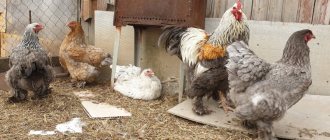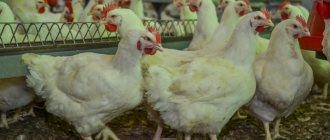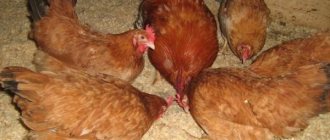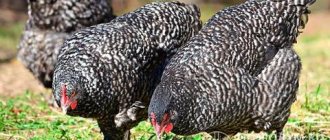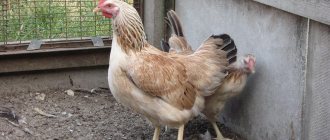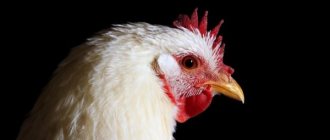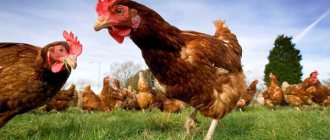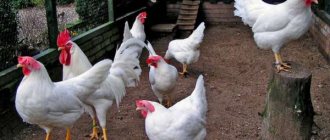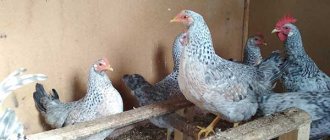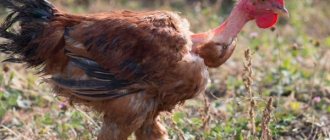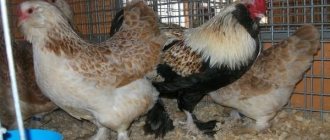The Ameraucana chicken breed is one of the most unique inhabitants of a private yard, which produces blue eggs. This chicken is also very often called “Easter”, because the eggs that the bird gives can be served at the holiday table even without prior coloring. This bird is famous among poultry farmers not only because of its unique eggs, but also because of its excellent meat products.
In today's article you will find a detailed description of the breed, see photos of a unique bird and read reviews from those who were lucky enough to meet it.
Origin story
Chile is considered the homeland of this unusual poultry. Ameraucana received its name from an Indian tribe living in the Andes highlands. To breed the breed, members of the tribe selected only the most fighting cockerels and laying hens, which gave the most blue eggs.
The first mention of this breed dates back to 1526, but it is known that the bird laying blue eggs appeared long before Columbus discovered America. One theory is that chickens produce blue eggs because poultry was once crossed with a pheasant, which is why this mutation occurred.
However, this is just a theory. Scientists have a different version. In their opinion, the blue color of the shell is the merit of the biliverdin pigment, which is contained in the shell of the Ameraucana egg.
The bird left the South American continent only in 1888. Already in 1965, it was included in the German standard and, accordingly, received its description.
Ten years later, in 1975, a dwarf variety of this breed was bred in America.
Description of Ameraucana
Ameraucana does not have a single plumage color. The American Poultry Association recognizes eight different colors:
- Black.
- White.
- Red-brown.
- Blue.
- Silver.
- Wheat.
- Wheat blue.
- Dark yellow.
In addition to these colors, there are others, for example, lavender. However, they are not officially recognized.
In addition to the standard breed, American breeders developed an ornamental dwarf breed.
Appearance
The appearance of representatives of this breed can be described as follows:
- Ameraucanas have fairly dense plumage and fluff all over their bodies. A special feature of this bird is the presence of sideburns and a beard, which almost completely hide the bird’s head.
- The legs are of medium length, set wide apart, and are white, blue or gray in color.
- The eyes are very large, red-brown in color.
- Erect comb. In the central part it is higher than at the edges.
- The lobes are small, oval-shaped, red in color. Males have brighter lobes.
- The tail is small, located at an angle of 45 degrees relative to the body. Males have a sickle-shaped tail.
- The beak is massive, curved.
- The wings are large and well developed. This bird can fly.
- Eggs can be more than just blue, although this is the most common shade. They come in gray, blue, olive and even green.
Appearance Features
Medium size, stern and important appearance are the main features of representatives of this breed. All this is a legacy from South American relatives. The body has the shape of an inverted triangle, and laying hens have a convex sternum and well-developed thighs.
The protective function from the cold is performed by the smooth and dense feather cover, and strong and powerful wings give the chickens the ability to fly. Another characteristic feature of Easter birds is a bushy beard with feathered whiskers.
Ameraucana chickens
One cannot ignore such a feature as egg products with multi-colored shells. Birds can lay eggs with the usual color - brown, and there are also olive, pink, green, pale blue specimens.
Character
Representatives of this breed cannot be called peaceful and friendly. Especially when it comes to males. Roosters are often very aggressive. They can attack not only other poultry or animals, but also their owner. They often attack their own chickens. For this reason, roosters are usually kept separately from hens. Aggression is not the only disadvantage of cockerels of this breed. They are also very active and incredibly inquisitive, which makes them unable to sit still.
Productivity
Most often, representatives of this breed are chosen as poultry not because of its productivity indicators, but because the bird lays blue eggs.
Ameraucana ripens quite early, at 5 months of age. Sometimes hens lay their first clutch earlier, sometimes later. It all depends on the conditions in which the bird is kept.
Egg production rates are significantly inferior to those of modern egg crosses, but are more than acceptable for home conditions. One laying hen produces up to 200 eggs per year. The eggs are quite large, about 65-70 grams.
As for the meat, it is very tasty, juicy and tender. The weight of a mature rooster reaches 3.5 kg, while laying hens weigh about 2.5 kg.
Problems during cultivation
When raising this breed of chicken, the most common difficulty that a breeder faces is the problem when the chickens stop laying eggs or get sick.
Often, the poultry farmer is overcome by the question: laying hens are not laying eggs - what to do to restore egg laying. In this case, the first step is to review the birds’ diet, how balanced it is and whether there are enough vitamins.
In case of such a problem, the breeder definitely needs to know how to increase the egg production of chickens at home - germination and yeast are useful methods without the use of medications.
The first option involves germinating the grains and adding them to the mash. Yeasting food has also proven itself to be excellent - for this, 30 grams of yeast are diluted in one and a half liters of water, and a kilogram of grain is poured into it.
After ten hours of waiting, the prepared composition is added to the feed in a ratio of 1 tablespoon per bird.
Another equally unpleasant problem for egg-laying chickens is egg pecking. Large farms and poultry farms know what to do to prevent chickens from pecking eggs - for this they supply supplements containing calcium. At home, crushed shells and chalk are suitable. Another important condition is whether there is enough space for the bird to walk; if it is small, pecking of eggs is a common occurrence.
If chickens lay eggs without shells, what should you do in this case? To eliminate this problem, the poultry farmer must find out its cause. This could be: an incorrectly composed diet, hormonal imbalance, illness.
As for hormonal disorders and diseases in birds, the help of a veterinarian will be required. More details about the latter below.
Chicken diseases are often a problem for breeders. They not only affect egg production or the phenomenon when an egg has no shell, but they also threaten worse consequences, including the death of the livestock.
For example, if chickens have a cough, the cause may be infectious bronchitis, a cold, or mycoplasmosis.
Pullorosis sounds no less frightening when there is a disorder of the gastrointestinal tract, or colibacillosis, which is characterized by decreased activity and thirst.
In such cases, there is no point in delaying, because the breeder risks losing his livestock; it is important to contact a specialist who will prescribe the appropriate antibiotics. Briefly describing Australorp chickens, we can say that their maintenance is profitable, and their productivity indicators are at the highest level
At the same time, the growing conditions are simple, and all that is required is the labor and attentiveness of the breeder
Briefly describing Australorp chickens, we can say that their maintenance is profitable, and their productivity indicators are at the highest level. At the same time, the growing conditions are simple, and all that is required is the labor and attentiveness of the breeder.
Hatching instinct
Almost all purebred breeds have a good brooding instinct. Unfortunately, the Ameraucana breed is an exception. Ameraucana cannot hatch its offspring. But if the hen decides to sit on the eggs, she won’t last long. She will get up and go about her business, completely forgetting about the previous lesson. But this is not the only drawback of representatives of this breed. Unlike other chickens, who treat their offspring with love, Ameraucanas often show aggression towards their own chickens. It is not uncommon for adults to peck young animals.
Because of this attitude, young individuals are kept separately from older residents until the former grow up.
How to select material for incubation
When deciding on incubation, you need to familiarize yourself with the recommendations for selecting quality eggs:
- Products that are stored no more than seven days after they were collected are suitable;
- eggs should have a classic shape - oval. It is necessary to carefully inspect the products; there should be no dents, cracks, or deformations on the shell;
- chicks hatch better if the incubation material is handled carefully;
- at low temperatures down to +8, embryo death can occur, and therefore, if the eggs were stored in inappropriate conditions, they are not used for incubation.
Advantages and disadvantages of the breed
This bird has a number of advantages, thanks to which it still successfully competes with more productive crosses. Among the main advantages of Ameraucana are the following:
- Unique multi-colored eggs. This is perhaps the main reason why the bird is in great demand. Many people mistakenly believe that Ameraucana only produces blue eggs, but this is not true.
- Early maturation. Already at 5 months of age, the bird can lay its first clutch.
- High productivity. Ameraucana is quite productive for poultry. She can produce about 200 eggs per year. The eggs are large and rich in useful elements. Peak productivity lasts about 2 years from the first egg laying.
- Both hens and cockerels gain muscle mass very quickly. Ameraucana meat is white in color and has high taste. The taste and aroma of the meat of this bird is very similar to quail.
- The bird is quite easy to keep. Thanks to their dense plumage, chickens are not afraid of low temperatures.
Does this bird have any disadvantages? Yes, they are. First of all, the main disadvantages of this breed include:
- Laying hens have very poorly developed maternal instinct. Laying hens almost never hatch new offspring.
- Roosters of this breed are quite aggressive individuals. They can be aggressive towards their own chickens, as well as towards pets, people, etc.
Historical reference
Some farmers confuse the described breed with the more famous species of birds - the Araucana. Birds differ significantly due to a number of factors:
- origin story;
- productive qualities;
- content requirements.
Almost the only common feature is the similarity of the two breeds, which, in general, is not surprising, because the Ameraucana are descendants of the Araucanas.
Selection work with chickens began in 1970, for crossing, American scientists took local chickens and Araucanas that did not have a tail. The new breed standard was approved in 1984. Along with a high egg production rate, birds can boast of meat products that are tender and have unusual taste qualities. Due to the combination of two types of productivity, chickens were classified as meat-egg or mixed type.
Care and maintenance
There are no special requirements for care and maintenance. The only thing that needs to be taken into account is that Ameraucana is a very active bird and in cage conditions it will feel very bad. Therefore, it is advisable to keep chickens in a spacious chicken coop, with the possibility of walking in the back yard.
Otherwise, keeping poultry comes down to a number of standard rules:
- The chicken coop should have good ventilation, be warm and clean. Ventilation is necessary in order to saturate the room with fresh air and remove unpleasant odors from it. At the same time, it is necessary to ensure that there are no drafts in the room.
- It is advisable to arrange a bedding on the floor. It is made from suitable materials (sawdust, straw, peat, hay), which absorb moisture very well. The litter will not only insulate the room (in particular the floor), but also relieve the chicken coop from moisture. The ideal litter height is 15-20 cm. Periodically, you need to remove the top layer of litter and replace it with a new one.
- Birds often encounter parasites such as fleas and ticks. To combat and prevent invasion of these parasites, two methods are used. The first is to disinfect the premises. This is carried out at least once every 6 months. The second method is to install a container with wood ash in the chicken coop and in the yard. The bird will independently clean its feathers with ash and thereby get rid of or protect itself from these parasites.
- The chicken coop should also be equipped with perches and nests. Perches are placed at a height of 50-60 cm from the floor. They should be spacious. For each chicken, the perch should be at least 20 cm. Nests are also arranged at a height of 50-60 cm from the floor. Nests should be comfortable for the bird. The ideal dimensions of the nest are 40x40 cm.
- Don't forget about lighting. In winter, daylight hours are significantly reduced. This leads to the fact that poultry productivity rapidly decreases. To prevent this from happening, daylight hours are artificially extended. For this, ordinary “yellow” incandescent lamps are used.
- The chicken coop must have a drinking bowl and a feeder. The drinking bowl should always be clean and filled with water. The water is changed 2 times a day in summer, 1 time in winter. It is recommended to install the drinker and feeder against the wall so that the bird does not have the opportunity to knock them over. Also, many poultry farmers practice installing nets on feeders. The net should be such that it will protect the food from the bird’s feet and its droppings, but at the same time will not impede access to the food.
Breeding
As soon as the adult herd turns 1 year old, it is time to think about breeding a new generation. The poultry farmer must be aware that the maximum productive period lasts from 1 to 2 years, then egg laying becomes less active, and the quality of the meat deteriorates significantly.
Rules for choosing eggs for an incubator
If you have decided to start breeding Ameraucana on your property, then you should understand and correctly select eggs for the incubator. Buying a suitable purebred egg will cost you 200 rubles apiece. Opt for the larger ones.
The main points of choosing eggs for the incubator:
- The age of the eggs is from 2 to 7 days after laying.
- The egg should have a standard oval shape.
- It is almost impossible to illuminate it well, so check for cracks in good lighting.
- Before being placed in the incubator, the embryo in the egg is already developing. Be extremely careful with it so that it does not fall or break.
- The embryo dies at temperatures from +5 to +8 degrees Celsius. If eggs have been exposed to this temperature, they cannot be used in an incubator.
Read the article about the features of incubating chicken eggs at home.
Chick care
Ameraucana chickens are much easier to raise than other chicken varieties. The young are already born with plumage; they have warm down, which protects the babies from hypothermia and drafts. Chickens are very active, they have an excellent appetite, so they grow quickly and develop well.
Many poultry farmers are confident that future productivity depends on caring for the young in the first two months after birth. At this time, the chickens' skeleton and muscle mass are fully formed. After 2.5 months, the birds will begin to gain weight twice as fast as before. 3 months after birth they will begin to consume a lot of food.
During this period, it is necessary to monitor each bird so that no one is offended, each hen gets food and water, and they should gain weight approximately equally.
Industrial breeding of Ameraucana chickens involves the artificial division of young animals into large and small individuals. Sorting birds into such groups will help the breeder achieve full and uniform development of the flock.
Without this activity, some birds will remain hungry and will not grow as desired. Some individuals will become overly aggressive and lively, and leaders will begin to appear in large groups who will begin to eat food faster than weaker chickens. All this will negatively affect the overall weight of the livestock. After 5 months, the chickens begin to lay eggs.
Poultry farmers prove that the larger the hen, the faster she begins to lay eggs, and the larger they turn out.
Top tips for caring for chickens:
- To stimulate the development of young animals, leave the light on for the first two days, then alternate 2 hours of “night” with 4 hours of “day”.
- Build the chicken coop spacious and ventilated. To save time on cleaning it, keep the young animals in cages. Place drinking bowls and feeders in them. How to make a feeder yourself is written here.
This article describes how to make a drinking bowl with your own hands.
Diet of young animals
The Ameraucana chicken menu is standard. The basis of the diet is food high in protein and calcium. In the first days, babies are fed a boiled egg mixed with semolina, then greens and special vitamins are added.
By the age of 1.5 months, food is supplemented with boiled vegetables. The presence of a good appetite and stable development lies not only in food, but also in its diet. From the first day, the young are fed every two hours. About 18 days after birth - 5-6 times a day, after which they switch to 3-4 meals a day.
A mandatory component is clean and fresh water; the more young animals drink it, the better. Adult chickens and babies are very sensitive to the quality of water, so it must be boiled and cooled.
The young are very strong, but up to a certain age the babies are kept warm. The first 7 days the temperature is up to +32 degrees Celsius, the next - up to +30 degrees, so it is necessary to reduce the indicator to +26 degrees.
Diet
There are no special tricks in terms of feeding representatives of this breed. A standard diet is quite suitable for the bird. Typically, owners of chickens of this breed begin feeding with starter feed. Some people prepare their own food. In this case, you need to start from two factors: the feed must be absorbed by the young chicken’s body and have high value indicators.
To feed adult birds, you can use wet mash, vegetables and grains. It is best to pour clean, not cold water into the drinking bowls.
We also recommend reading: Description of the Amrok (Amroks) chicken breed
In addition, do not forget about the sources of calcium. The main sources of calcium are:
- Food chalk.
- Ground eggshells.
- Meat and bone/fish meal.
- Crushed shell rock.
Subtleties of caring for chickens
Raising chickens is not such a complicated procedure as it seems at first glance. Ameraucans are quite unpretentious from the early days of their life and have a fairly strong immune system. Thanks to its active lifestyle, the bird grows and develops very quickly. When breeding chickens, you must adhere to the following rules:
- Lighting. In the first three days of a bird's life, it is necessary to provide it with round-the-clock lighting. Then, gradually, daylight hours are reduced. Already by 3 weeks of age it should be about 9 hours a day.
- For three weeks, the young animals are fed at least 5 times a day (ideally 6). It is advisable to divide meals into hours. Frequent feeding promotes faster development of chickens.
- Young animals should not be given dirty water. Drinkers must be cleaned regularly and the water changed.
- It is recommended to divide the chicks into groups according to size so that the chicks develop evenly. The fact is that a larger bird can dominate and take food from weaker representatives of the breed, which naturally will lead to even greater stunting.
conclusions
- The Cornish breed is a meat breed. Their meat is considered the most dietary and tender.
- Representatives of the species should be kept on free grazing, since cellular grazing causes problems with fat deposits and, as a consequence, complications of health and taste.
- Feeding chickens is quite simple, as they are unpretentious eaters. The wishes of specialists include an emphasis on legumes, grains, and food. With increased protein content.
- Due to late puberty and timid nature, nuances arise during breeding. Most often, farmers place eggs in an incubator to hatch. This link will tell you about the “Ideal Hen” incubator.
Reviews
Irina Vladimirovna, Kyiv, 42 years old.
I raised the breed back in 2014. She kept it for one generation, then switched to another bird. I grew them purely out of interest, because I wanted blue eggs. I didn’t like the roosters because they are quite fighting roosters and it’s scary to walk near them. I also didn’t like the fact that almost only roosters hatched from my eggs, and I don’t like roosters - see above. As for the chickens, they are quite interesting. The appearance is unusual, at the age of one they were already producing eggs weighing 70 grams, which I consider a very good indicator.
Vladimir Viktorovich, Moscow, 51 years old.
In 2022, I started growing Ameraucanush. Then he also took the Marans. Then one day I go into the chicken coop, and there is an egg there. So as not to sound strange, like why am I surprised, the chickens were only 2.5 months old. The egg is blue, laid by an American mother. In addition, I weighed it, 43 grams, which is quite a lot for such tiny things. This is the first breed that came to me at such an early age in all the time that I have been raising poultry.
Purchasing individuals
Before purchasing Ameraucana chicken, read the photos of chickens and roosters, as well as videos of experienced poultry farmers. It is better to purchase poultry from trusted sellers with a positive reputation. Give preference to nurseries, as in an unverified place they may sell you other people’s mixtures. Such cases are not uncommon, because before plumage it is difficult to determine the breed. The price for chickens and adult hens differs, but is generally affordable.
There are many positive reviews from farmers about this breed, because the birds have a large list of advantages and a small list of disadvantages, which have already been mentioned.
The Easter chicken is a great addition to any poultry yard. It’s hard to imagine what would have to happen for someone to be dissatisfied with the purchase of such overseas beauties.

